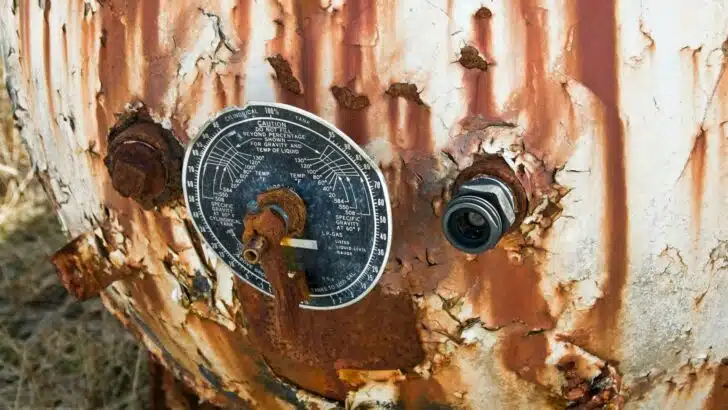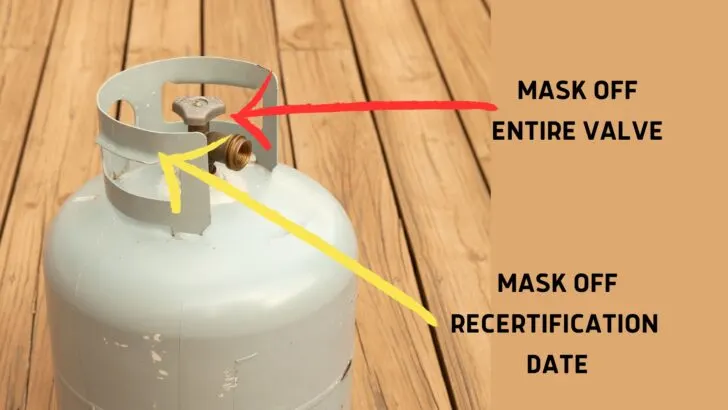Unless your RV is pretty new, having a rusty propane tank is not all that unusual. But there’s rust… and then there’s RUST. A little bit of surface rust in non-critical areas of a propane tank can generally be repaired pretty easily.
But the trick is to repair rust on a tank when it’s barely there… before it can seriously damage the tank. In this post, we’ll tell you how to do that. We’ll also tell you when a propane tank is rusted beyond reasonable repair, which is even more critical.
Is a Rusty Propane Tank Safe?
The answer to this question depends on the extent and location of the rust. As we mentioned in the introduction, a little surface rust on the outside of a propane tank isn’t uncommon… or likely dangerous. But anything other than a bit of surface rust is cause for concern because it can eat away at the walls of the tank, causing them to become thin and brittle.
Here’s a photo of an ASME tank with excessive rust. Pretty obviously, this tank is so badly rusted it should never be considered a candidate for repair. But it does show how badly compromised the outside propane tank can become.

Clearly, this ASME propane tank is dangerous and far beyond repair.
Rust is capable of eating a hole completely through metal. Thinning/compromised metal could allow liquid propane gas to escape, which can be a recipe for disaster. A tiny hole or hairline crack is all it takes.
If rust is excessive, forget repairs. It’s time to replace the tank.
If you’re unsure if your rusty propane tank is leaking, you can test for leaks by pouring a soapy water solution over the area in question (a little dish soap mixed with a small amount of water will do). Do the same if you’ve got a propane tank that’s become rusty around the valve. If you see any bubbles (seriously… ANY bubbling at all), there’s a leak.
If it’s a built-in tank, immediately take it to a professional propane dealer. If it’s a portable tank, replace it as soon as possible. For more, see our posts RV Propane Tanks: What to Know for Safety & Comfort, and How Long Are Propane Tanks Good For on an RV?
So, the short answer as to whether or not a rusty propane tank is safe is NO… with the only exception being very minor surface rust that hasn’t progressed very far. Tending to minor surface rust early is the way to keep the tank safe.
Can a Propane Tank Rust On the Inside?
Yes. And because that’s an unseen problem, it’s even more dangerous. But there’s a way to reduce the risk of this happening. An empty propane tank is an invitation to moisture which can cause a propane tank to rust inside.
Not only can rust build up in the tank unnoticed, but it’s also not repairable. This is partly because you don’t know it’s there, and partly because the interior of the tank is inaccessible.
Keeping your propane tank filled, especially when sitting unused for extended periods, will help prevent moisture from invading the inside of your tank and causing rust.
If you’re concerned about propane aging inside the tank, be sure to read our post “Does propane go bad?”
How Do You Keep a Propane Tank From Rusting Beyond Repair?
As mentioned, the best way to keep a propane tank from rusting to the point where it compromises the integrity of the tank, and your safety, is not to let it get to that point. The first step is to give the tank a thorough visual inspection periodically. Find rust early and take care of it.
Now, let’s talk about how to deal with minor surface rust to keep a propane tank viable for a long time. We suggest doing the following when your propane tank is empty, or very low.

Mask off the entire valve and the recertification date before painting.
- Use a wire brush to remove flaking paint and loose debris. You can also lightly sand the area using fine-grit sandpaper or steel wool.
- Using a 50/50 solution of vinegar & water, clean the tank well. Do a final rinse with water. Allow the tank to dry.
- Apply painter’s tape to mask off the valve, any warning labels, and the collar of the tank where the date is stamped.
- Use a quality primer like Rustoleum “Stops Rust” to prepare the surface for painting.
- Paint the tank using high-heat Rustoleum that’s either white or off-white.
- Once the paint has dried, remove the painter’s tape.
Once again, if there’s any question about any area of the tank, take it to a professional for assessment and leak testing.
- Use to prime exterior or interior heavily rusted metal surfaces only
- Oil-based formula provides a durable protective coating with excellent rust prevention
- Ideal for updating the exterior of barbeque grills, wood-burning stoves, radiators, engines or other metal items
- Oil-based formula designed to renew and protect metal surfaces subject to heat up to 1000°F
- Ideal for updating the exterior of barbeque grills, wood-burning stoves, radiators, engines or other metal items
- Oil-based formula designed to renew and protect metal surfaces subject to heat up to 1200°F
As we noted in our general post on RV propane tanks, portable cylinders must be replaced or recertified every 12 years (10 years in Canada).
Made of thicker, heavier steel, ASME tanks are designed for more permanent applications and don’t require periodic recertification. However, they should still be inspected for rust, damage, and leaks on a routine basis.
A slightly rusty propane tank doesn’t have to be a big deal. As with many other RV maintenance items, keeping up with periodic inspections is the key. We hope this info helps you keep up with yours.
An Important Reminder
In any propane-related post, we like to include a reminder to check your RV propane detectors’ date and proper operation. Here’s our real-time propane detector replacement video:
Free RVing Tips, Tricks, Reviews, Giveaways & More
Subscribe to our daily newsletter! We’ve been full-time RVers for 20 years (!) and share everything we’ve learned about RVing in our daily blog posts. Join our online community to receive a wealth of great RVing knowledge delivered right to your inbox.
Whether this is your first time on the road or you’re a seasoned full-timer, you’ll love the wide range of RVing topics we cover. Don’t miss a single article or any of our famous RV gear Giveaways — Subscribe today!





Pat Parker
Friday 7th of July 2023
Great info